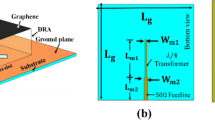Abstract
We propose a modified design for a photonic crystal fiber (PCF) polarization filter based on surface plasmon resonance (SPR). The air holes are arrayed in diamond lattices, and the diameter of the holes around the gold-coated holes are different that can separate the refractive index of the x-polarization and y-polarization second order surface plasmon polariton (SPP) modes. The influences of structural parameters of the photonic crystal fiber (PCF) on the filter characteristics are studied using the finite element method (FEM). Great changes have taken place in the results of numerical simulation by changing the thickness of the gold film and air hole diameter. Simulation results show that the resonance wavelength is communication wavelength 1550 mm, the loss of the y-polarization mode is 43,126.7 dB/m. When the length of the fiber is 500 μm, extinction ratio is more than 20 dB at the communication wavelength, and bandwidth achieve to 190 nm. It is an important property of PCF polarization filter in production.








Similar content being viewed by others
References
Russell P (2003) Photonic crystal fibers. Science 299(5605):358–362
Kuhlmey BT, Pathmanandavel K, McPhedran RC (2006) Multipole analysis of photonic crystal fibers with coated inclusions. Opt Express 14(22):10851–10864
Koshiba M (2002) Full-vector analysis of photonic crystal fibers using the finite element method. IEICE Trans Electron 85(4):881–888
Koshiba M, TsujiY (2000) Curvilinear hybrid edge/nodal elements with triangular shape for guided-wave problems. J Lightwave Technol 18(5):737–743
Hansen TP, Broeng J, Libori SEB, Knudsen E (2001) Highly birefringent index-guiding photonic crystal fibers. IEEE Photon Technol Lett 13(6):588–590
Birks T, Knight J, Russell P (1997) Endlesslysingle-modephotonic crystal fiber. OSA Opt Lett 22(13):961–963
Liu Q, Li Q, Fan Z, Zhang W, Li H, Zi J, An GW (2015) Numerical analysis of ultrabroadband polarization splitter based on gold-filled dual-core photonic crystal fiber. Opt Commun 334:46–50
Liu Q, Li SG, Chen HL, Fan Z, Li JS (2015) Photonic crystal fiber temperature sensor based on coupling between liquid-core mode and defect mode. IEEE Photon J 7(2):1–9
Hameed MFO, Obayya SSA (2011) Design of passive polarization rotator based on silica photonic crystal fiber. Opt Lett 36(16):3133–3135
Chen MY, Zhou J, Pun EY (2009) A novel WDM component based on a three-core photonic crystal fiber. J Lightwave Technol 27(13):2343–2347
Rosenstein B, Shirakov A, Belker D, Ishaaya AA (2014) The 0.7 MW output power from a two-arm coherently combined Qswitched photonic crystal fiber laser. Opt Express 22(6):6416–6421
Robin C, Dajani I, Pulford B (2014) Modal instability suppressing, single-frequency photonic crystal fiber amplifier with 811 W output power. Opt Lett 39(3):666–669
Kuo SM, Huang YW, Yeh SM, Cheng WH, Lin CH (2011) Liquid crystal modified photonic crystal fiber (LC-PCF) fabricated with an un-cured SU-8 photoresist sealing technique for electrical flux measurement. Opt Express 19(19):18372–18379
Schmidt MA, Russell PSJ (2008) Long-range spiralling surface plasmon modes on metallic nanowires. Opt. Express 16(18):13617–13623
Gauvreau B, Hassani A, Fassi Fehri M, Kabashin A, Skorobogatiy MA (2007) Photonic bandgap fiber-based surface plasmon resonance sensors. Opt Express 15(18):11413–11426
Lee H, Schmidt M, Tyagi H, Sempere LP, Russell PSJ (2008) Polarization-dependent coupling to plasmon modes on submicron gold wire in photonic crystal fiber. Appl Phys B Lasers Opt 93(11):111102
Vial A, Grimault AS, Macias D, Barchiesi D, Chapelle ML (2005) Improved analytical fit of gold dispersion: application to the modeling of extinction spectra with a finite-difference time-domain method. Phys Rev B 71(8):085416
Xue J, Li S, Xiao Y, Qin W, Xin X, Zhu X (2013) Polarization filter character of the gold-coated and the liquid filled photonic crystal fiber based on surface plasmon resonane. Opt Express 21(11):13733–13740
Acknowledgements
This work was supported by the National Natural Science Foundation of China (Grant Nos. 61475134 and 61505175).
Author information
Authors and Affiliations
Corresponding author
Rights and permissions
About this article
Cite this article
Feng, X., Du, H., Li, S. et al. A Polarization Filter Based on Photonic Crystal Fiber with Symmetry Around Gold-Coated Holes. Plasmonics 13, 1271–1275 (2018). https://doi.org/10.1007/s11468-017-0630-1
Received:
Accepted:
Published:
Issue Date:
DOI: https://doi.org/10.1007/s11468-017-0630-1




